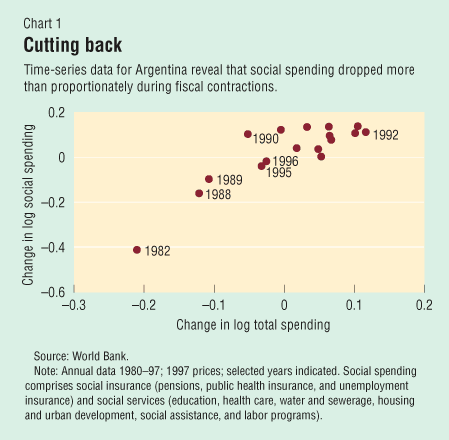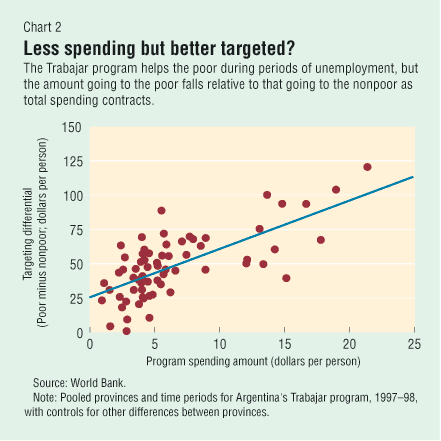 About F&D Subscribe Back Issues Write Us Copyright Information Free Email Notification Receive emails when we post new
items of interest to you. |
An Automatic Safety Net? Martin Ravallion
A series of World Bank case studies suggests that the poor bear the brunt of government spending cuts. Better safety nets that can provide more automatic protection are needed.
When countries cut total public spending as part of macroeconomic adjustment programs, the standard policy advice is to alter the composition of spending to protect the poor. Aid donors have been strongly supportive of public programs—such as "social funds"—that are designed to provide extra assistance to the poor during fiscal contractions. However, there is remarkably little evidence to draw on in assessing the case for such policies and their likely impact. Most important, we don't know how much the poor would be hurt by cuts in public spending in the absence of any intervention. To shed light on this question, a World Bank research project has looked at how the incidence of spending—how much goes to the poor relative to the nonpoor—varies with aggregate outlays. The findings confirm that special measures are needed to protect the poor. Spending cuts and the poor A clue to the incidence of budget cuts can be found by studying aggregate time-series data on the composition of public spending during government cutbacks. In the case of Argentina, for example, time-series data reveal that spending on social programs was generally not protected from budget cuts. Indeed, during the large fiscal contractions in the 1980s, social spending took a disproportionate hit (Chart 1). However, social spending in Argentina (as elsewhere) is a heterogeneous category that includes spending on items such as pensions, formal unemployment insurance, and higher education, which tend to benefit the nonpoor more than the poor, as well as more pro-poor spending on basic education and health care, social assistance, and active labor market programs. To throw more light on the success of social programs in reaching the poor, we need data that directly link public spending with its beneficiaries. The Bank's research project has tried to do this in three case studies, for Argentina, Bangladesh, and India.

The striking finding of all three studies is that, as programs expand, they tend to do a better job of reaching the poor. Conversely, when total spending falls, the poor tend to be less well targeted. In the India study, this was evident from how the participation rate of the poor relative to the nonpoor in various social programs varied across regions according to differences in the average participation rate. For the Bangladesh case study, a similar comparison was made between villages. In both cases, a higher average participation rate meant that relatively more of the poor participated. In other words, targeting worsened as total outlays fell.
Chart 2 illustrates the pattern found by the Argentina study, based on that country's Trabajar program. The vertical axis gives the "targeting differential"—the difference between the estimated per capita amount going to the poor versus the amount going to the nonpoor. The horizontal axis gives the corresponding total outlay per capita on the program. Each point in the chart represents one province in one subperiod of the program. It can be seen that the targeting differential is positive (which is good news) but that it tends to fall as the program contracts.
 The Trabajar program did help the families of poor unemployed workers in a time of need. Ex-post impact assessments of the program found that 80 percent of program disbursements were received by the poorest 20 percent of families in terms of income per capita—the program thus performed better than any other social program run by the central government. Nonetheless, the local political economy tends to protect program allocations to nonpoor areas when programs contract, while program expansions tend to favor poor areas. It is this feature of the political economy that results in the pattern evident in Chart 2, despite good overall performance in targeting the poor. In short, it appears from these case studies that it is spending on the nonpoor that tends to be protected from cuts. This can be explained in more than one way. It may be that contractions are associated with a shift in the balance of power over collective decision making, against the interests of the poor. However, even without this effect, when the nonpoor hold the balance of power over collective decision making in normal times, declining marginal utility of spending on the nonpoor can mean that there is a switch in spending away from the poor when an economy contracts. Policy lessons What lessons can we draw for policymakers? There is no sign in these case studies of an automatic safety net—one that would ensure an improvement in targeting performance when aggregate outlays fall. One implication is that extra efforts will be needed to protect the poor during fiscal contractions. A second implication concerns how policymakers should assess the impact of add-on programs designed to compensate those likely to be harmed by fiscal adjustment. In monitoring the outcomes of such programs, it is common to compare social spending before and after the program. However, this comparison ignores the political economy of fiscal incidence. The findings of these case studies suggest that past performance in reaching the poor is not a reliable guide to outcomes in the absence of intervention. Even restoring the preadjustment level of public spending on the poor can be consistent with large gains relative to what would have happened without intervention. Third, achieving a pro-poor shift in spending during a contraction is not politically easy and might well meet with stiff opposition. Even successful add-on programs—such as Argentina's Trabajar program—are not immune to the underlying forces in the political economy that help protect spending on the nonpoor from cutbacks. Deeper institutional and policy reforms are called for if the poor are to be more protected from fiscal adjustment. A better safety net? It is not clear that ad hoc add-on social programs introduced after a shock has occurred are the best way to protect the poor. A better approach is to design policies that automatically come into action when needed. This is not so far fetched. There is scope for establishing permanent programs that can respond rapidly to the income and other shocks facing the poor. Automatic protection is the essential idea of an important and long-standing class of antipoverty programs typified by the famous Employment Guarantee Scheme in the state of Maharashtra in India. This scheme is intended to assure income support in rural areas by providing unskilled manual labor at low wages to anyone who wants it. It automatically contracts in good agricultural years and expands in bad years. The scheme has been financed domestically, largely from taxes on the relatively well off segments of Maharashtra's urban populations, who appreciate the benefits they themselves derive from effective social protection for the poor—for example, such protection can decrease migration to cities in times of economic stress in rural areas. For such a public insurance scheme to work, funding for it must be secure, and permanent institutions must be able to disburse funds rapidly when needed. Setting up an automatic safety net will not be easy. Design features are also crucial to the success of such programs—notably, the wage rate must not be set too high. (There is evidence that the ability of the Maharashtra scheme to insure the poor has been jeopardized at times by a sharp increase in the wage rate.) Naturally, there are limits to the amount of social protection such schemes can offer. The work requirement means that not all those in need will be able to participate. Complementary transfers of cash or food will almost certainly be needed as well—targeted to specific groups who either cannot work or should not be taken out of other activities, notably school. Those who cannot be expected to work can be identified fairly easily by their ages or disabilities, although the administrative, political, and economic difficulties of doing so should not be underrated. Cash or food-for-education programs (such as the Bangladesh program discussed above) can help keep poor kids in school during times of economic stress. These transfer schemes will need to be allocated administratively and turned on and off according to indicators of crisis. The demand for relief work can provide a signal for this purpose; rapid expansion of demand for low-wage relief work is a good sign that other transfers also need to kick in. Although effective short-term social protection from economic shocks may well be the exception rather than the rule, some developing countries have demonstrated that it is possible to protect those who are poor or vulnerable. The claim sometimes heard that this is beyond the means of developing countries is demonstrably wrong; the evidence that it is the nonpoor who are protected belies the case that differential protection is unfeasible. The real challenge is to ensure that an effective safety net is a permanent institution, dealing simultaneously with macro crises and the problems of idiosyncratic risk in normal years. The cost to the budget need not be higher than that of existing schemes, although, in many settings, current spending on social protection may well be too low. Budgetary outlays might be highly variable over time, though possibly no more so than for overdue relief operations into which large sums of money have to be injected—often inefficiently. There might be unforeseeable crises for which extra external help will be needed. However, domestic funding should be sufficient to cover normal shocks as well as modest demand in normal years. What role should donors play? Entering the picture in a late and ad hoc way and naively running against the local political economy hardly constitute a credible external response. A potentially far more important role for external assistance is in assuring that an effective safety net is in place with secure funding, even in normal times. Setting up the capacity for effective social protection is no less important to the ultimate welfare objectives of economic policy in risk-prone economies than is taking the steps to ensure sustainable economic growth. Neither goal should be compromised to placate short-term political interests. This article draws on the author's paper "Who is Protected? On the Incidence of Fiscal Adjustment," which was presented at the Conference on Macroeconomic Policy and Poverty at the IMF on March 14, 2002.
|